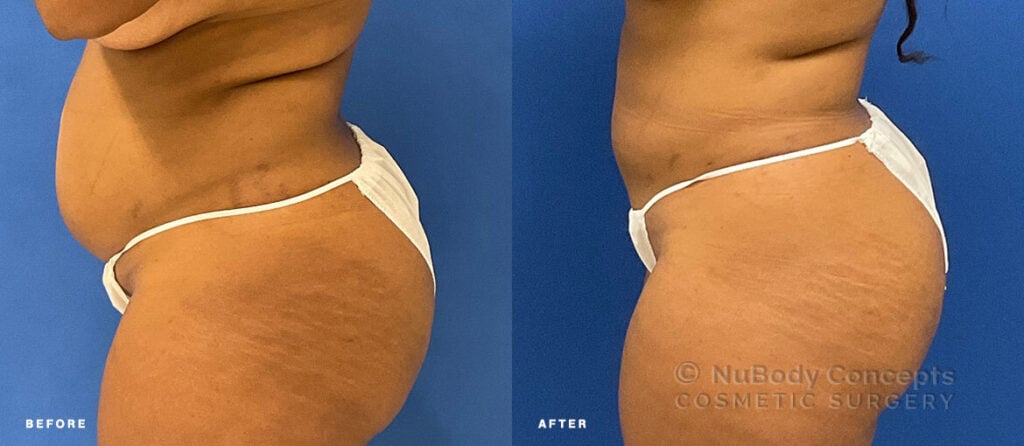
Medically reviewed by Dr. John Rosdeutscher – Written by Sine Thieme
Non-surgical skin tightening procedures use targeted energy to heat tissues under the skin. This stimulates collagen and elastin production and coagulates (i.e. shrinks) the skin, giving it better tone and texture. The same technology can also be used to apply targeted heat to the fibrous tissues that create the appearance of cellulite.
There are various FDA-approved technologies for non-surgical skin tightening on the market. Our staff at NuBody Concepts Cosmetic Surgery in Nashville and Memphis would love to help you achieve your body contouring goals without the need for surgery. Read on to learn everything there is to know about the pros and cons of minimally-invasive and non-invasive skin tightening.
Is Minimally-Invasive or Non-Invasive Skin Tightening Better?
Whenever you consider any type of cosmetic procedure to enhance or rejuvenate your appearance, you will need to consider what level of invasiveness you’re willing to tolerate for the kinds of results you’re looking for.
As a general rule:
More invasive = Great results, more downtime
Less invasive = Moderate results, less downtime
It is important to know the correct terminology when picking a skin tightening treatment. Non-surgical doesn’t have to mean non-invasive. It just means that it can be done without the classical tools of surgery, namely heavy sedation, a scalpel and sutures.
A minimally-invasive skin tightening procedure like Radio Frequency Assisted Lipolysis (RFAL) is non-surgical, but it is not entirely non-invasive, because the surgeon places a probe underneath the skin through very small incisions. BodyTite, FaceTite, and Renuvion all fall into this category. You will have some downtime with these procedures, but not nearly as long as with full surgery such as a tummy tuck or thigh lift.
Truly non-invasive skin tightening, on the other hand, requires no downtime at all. However, it typically needs a series of repeat treatments, is less permanent, and achieves less striking results. It is nevertheless a great option for patients with only minor skin sagging who prefer the least invasive option. Ultherapy,Exilis, Exilis Ultra, Morpheus8, and Thermage all fall into this group.
Minimally-Invasive Skin Tightening
If you are frustrated by a pouch of fat on your tummy, flabby arms, or a jowly neck, you’d probably love to find a way to get rid of them. Traditionally, this meant you needed a tummy tuck, an arm lift, or a facelift to surgically remove such unsightly skin folds. But if you had to pick, you’d probably prefer not to undergo surgery, right?
With recent advances in medical technology, you now have that option: Undergoing a radio frequency-powered treatment to tighten your skin – without surgery. This is an excellent compromise between surgery and non-invasive treatments. It is ideal for the so-called “gap patient” – someone who doesn’t want surgery and has a body type that responds well to a less-invasive procedure, but who needs more than the application of purely external heat to see results. Below we discuss the two market-leading technologies in this category.
How It Works
Radio Frequency Powered Skin Tightening, also called Radio Frequency Assisted Lipolysis (RFAL) is applied using a wand that emits controlled heat to the deeper tissues of the skin to “coagulate” and shrink them. After administering local anesthesia, the probe is inserted through several tiny, well-placed incisions without the need for scalpels or sutures. The downtime is short – most patients return to regular activities within just a day of the procedure.
BodyTite/FaceTite


BodyTite and FaceTite are FDA-approved technologies using the RFAL technology. Studies have shown that it can achieve 35% – 45% skin contraction. While this is short of the results seen in a surgical procedure like a tummy tuck, it is superior to what could previously be achieved with liposuction alone. Results can be seen immediately after the procedure but continue to improve for up to 12 months.
Renuvion
Renuvion is a very similar FDA-approved RFAL device. Like BodyTite it is used to contract tissues, and like FaceTite it comes with a smaller wand that can be used on the face and neck. The difference to BodyTite is that Renuvion emits bursts of helium plasma, allowing it to heat up and cool down again more rapidly. In studies on patients, Renuvion has achieved up to 60% skin contraction, with results continuing to improve for 6-9 months.

Skin Tightening With Renuvion vs BodyTite
Again, Renuvion and BodyTite are two very comparable technologies, with BodyTite having been around longer before Renuvion got its FDA approval. It is important to remember that your results mainly depend on the skill of your plastic surgeon. Finding a well-experienced surgeon who performs a lot of skin tightening and other cosmetic surgery who you feel comfortable with will be more important than favoring a specific device for your procedure.
At NuBody Concepts, our Nashville plastic surgeon Dr. John Rosdeutscher uses Renuvion on his skin tightening and non-surgical facelift patients. He is certified by the American Board of Plastic Surgery with over 25 years of experience. Dr. Rosdeutscher was voted Best Plastic Surgeon in the Best of Music City awards three years in a row – 2020, 2021, and 2022.
Non-Invasive Skin Tightening
Remember, there is a difference between Minimally-invasive and non-invasive skin tightening treatments. As previously discussed, minimally-invasive technologies are going to yield better results – with the downside of requiring some recovery time.
Non-invasive treatments do not require any recovery because your body is not taxed by them in the same way. If you have only slight skin laxity and really do not want to undergo a procedure that requires sedation, you may prefer a series of non-invasive treatments.
Non-Invasive skin tightening can be further divided into Ultrasound and Radiofrequency (RF) methods. Below we discuss various FDA-approved technologies in each group.
Ultrasound Skin Tightening
These treatments use focused ultrasound energy to heat skin by external application only. They can affect tissues up to 5mm deep to induce collagen production and firm up the skin. A handheld device transmits ultrasound waves through the skin’s surface. It can be used for older patients looking for a non-surgical facelift or for younger patients who want to prevent skin laxity as they age.
Ultherapy® is the most widely used FDA-approved ultrasound technology to tighten skin on the brow, chin, neck, and chest. A treatment can take from 30 to 90 minutes and can provoke mild discomfort during delivery. You will typically need repeated treatments as results are expected to last up to a year.
If you are not quite ready for facelift surgery, one or more Ultherapy treatments may allow you to postpone it for several years.
Radiofrequency Skin Tightening
Radiofrequency (RF) energy can also be used externally to heat the skin and trigger collagen production. It uses the same energy source as BodyTite and Renuvion but is not the same, as those treatments do penetrate the skin – even though short of full-fledged surgery.
Unlike ultrasound, radiofrequency targets the outer layer of your skin or epidermis. It can also be combined with microneedling (radiofrequency microneedling) to treat deeper layers of skin. RF treatments may take 2-6 treatments to achieve the desired results, which typically last up to three years.
FDA-approved non-invasive skin tightening treatments include Exilis®, Morpheus8®, and Thermage®. Like ultrasound treatments, RF treatments can be used to smoothing and tightening skin in older patients and delaying the need for face lift surgery in younger patients. But they are not limited to the face – RF treatments are designed for the entire body and are typically safe for all skin types.
Typical Problem Areas
Non-invasive skin tightening can be applied to the entire body. Here are some common uses:
- Reduce a double chin
- Tighten lax abdominal skin
- Reduce stretch marks
- Reduce a belly bulge
- Shrink love handles
- Rejuvenate vaginal tissues
- Reduce saddlebags
- Reduce cellulite on thighs and buttocks
Surgical Skin Tightening
A discussion of skin tightening methods wouldn’t be complete if we didn’t mention surgery. In a way, nothing tightens skin quite as much as simply removing the excess skin altogether. A tummy tuck is the most effective method for removing fat and excess skin from the abdomen. Of course this comes with a few downsides, namely a longer recovery period as well as significant scarring, even though plastic surgeons are very skillful in hiding such incisions where they are well placed under the bikini line or hairline.
Some patients may only be able to have their skin tightened with surgery, particularly those who have a large amount of loose skin. If you have undergone substantial weight loss or multiple pregnancies that have stretched your skin beyond return, a tummy tuck may be the only way to flatten your stomach and tighten your abdominal skin.

Does Skin Tightening Work?
You might ask, which of all these procedures is best? As we have explained above, it really depends on your goals and your body type. Do you need a massive amount of skin removed? You may not get around a tummy tuck. Do you only have mild skin laxity and don’t mind a few repeat treatment as opposed to a more invasive procedure? Then a non-invasive ultrasound or radiofrequency treatment might be best.
You should also take into consideration that a surgeon’s skill and experience are important factors. Picking an experienced, board-certified cosmetic surgeon you are comfortable with is critical. Most plastic surgeons will use two or more of the above techniques in one session.
We hope that we’ve given you a better understanding of available skin tightening methods. If you are ready to get started, use the pink button to schedule a consultation with our board-certified plastic surgeon in Nashville or Memphis.















